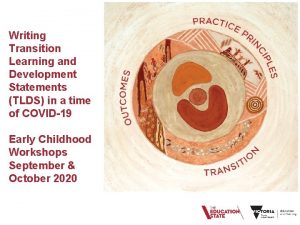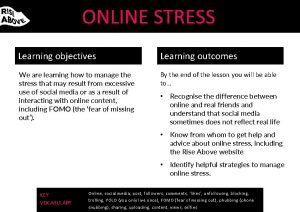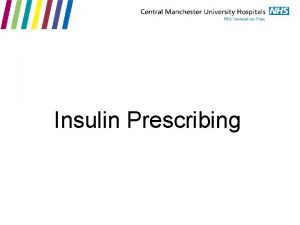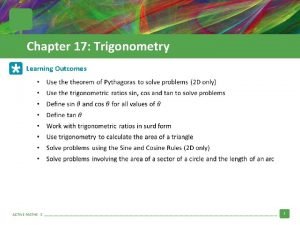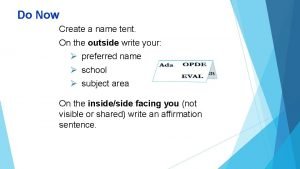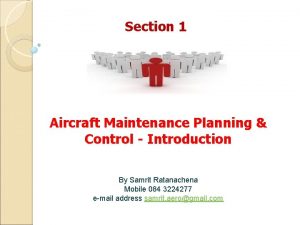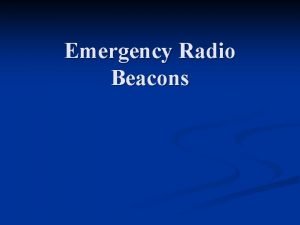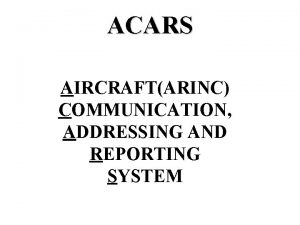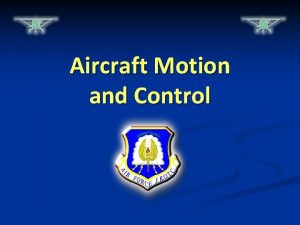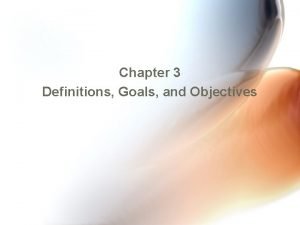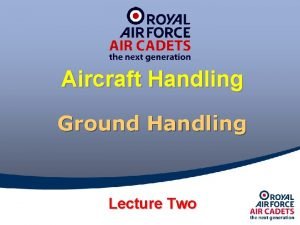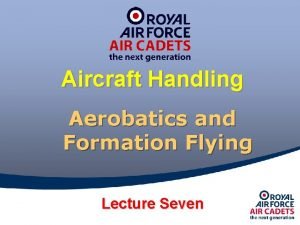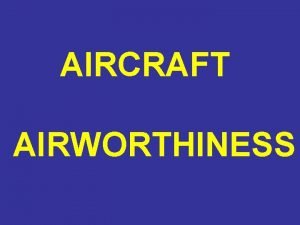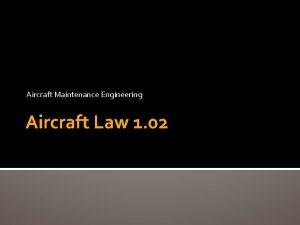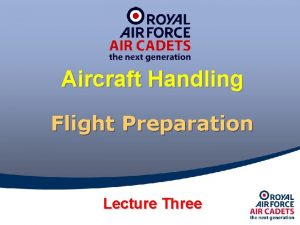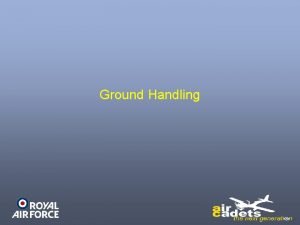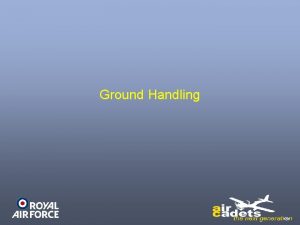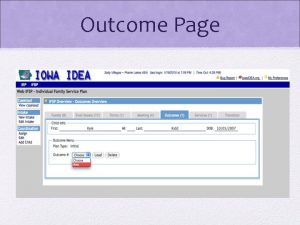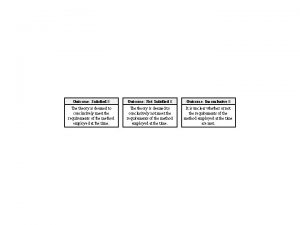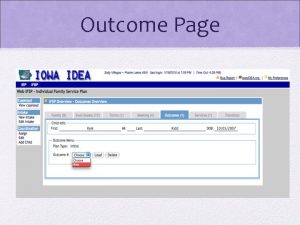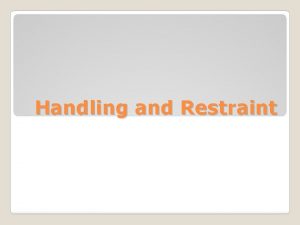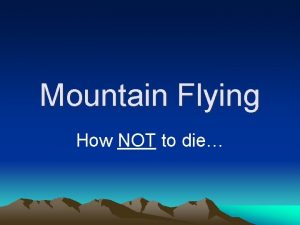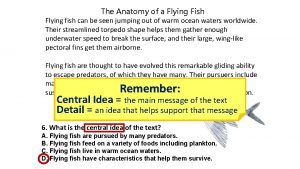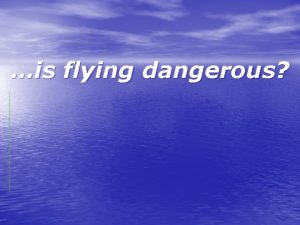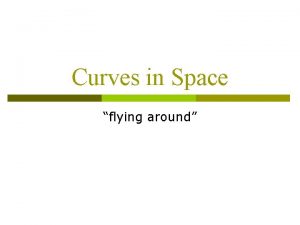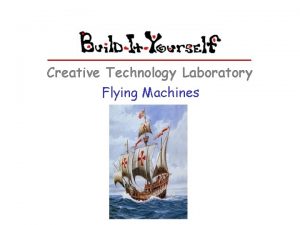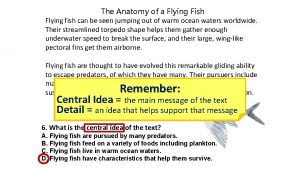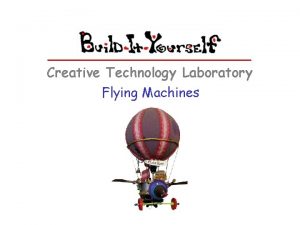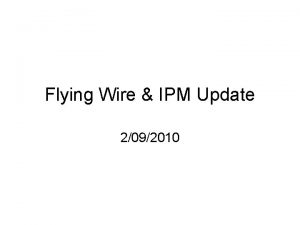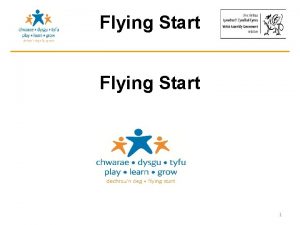Aircraft Handling and Flying Techniques Learning Outcome 1

























- Slides: 25

Aircraft Handling and Flying Techniques Learning Outcome 1 Reference: AP 3456 Vol 5, Pt 1, Sec 1 Aircraft handling and flying techniques

LO 1 Know about aircraft maintenance and ground handling techniques • P 1 - Outline the reasons and objectives for aircraft maintenance • P 2 - Describe what is meant by aircraft modifications • P 3 - Outline ground handling techniques • P 4 - Identify hazards and risks when ground handling aircraft Aircraft handling and flying techniques

P 1 - Outline the reasons and objectives for aircraft maintenance RAF Maintenance Policy - A balance of preventative and corrective maintenance Objectives - Maintenance Objectives - Operational Objectives Aircraft handling and flying techniques

P 1 - Outline the reasons and objectives for aircraft maintenance Operational Objectives - Generate aircraft and equipment to meet: - A counter-surprise alert - NATO and national commitments - Support intensive flying operations in hostile/NBC environments - Satisfy contingency plans - Provide serviceable aircraft and equipment to meet peacetime needs Aircraft handling and flying techniques

P 1 - Outline the reasons and objectives for aircraft maintenance Maintenance Objectives - Minimize faults - Minimize the manpower and resources required - Identify methods for improving reliability and maintainability Aircraft handling and flying techniques

P 1 - Outline the reasons and objectives for aircraft maintenance Maintenance Types - Preventative Reduces probability of failure Servicing Scheduled maintenance Out of Phase maintenance Condition-based maintenance - Corrective After a fault has occurred - Contingency In the transition to war Aircraft handling and flying techniques

P 2 - Describe what is meant by aircraft modifications Modifications of an aircraft: - Enhance operational capability - Improve reliability - Reduce servicing costs Modifications are an integral part of maintenance policy as embodiment would: - Raise costs - Increase aircraft downtime - Effect equipment availability Modifications need special authority and must be closely monitored Aircraft handling and flying techniques

P 3 - Outline ground handling techniques Seeing In/Off Aircraft are seen in/off by a handling team of usually two tradesmen. Handling Team Responsibilities: - Marshalling - Inserting/removing chocks - Attaching/removing ground power - Positioning and manning fire extinguishers - Positioning steps - Fitting/removing safety devices, covers and blanks Aircraft handling and flying techniques

P 3 - Outline ground handling techniques Marshalling Signals Assists the pilot in the safe manoeuvring of aircraft on the ground Signals are standard throughout the RAF iaw STANAG 3117 (Standard NATO Agreement) Pilot is always responsible for the safety of the aircraft - Not required to follow marshalling instructions considered unsafe Aircraft handling and flying techniques

P 3 - Outline ground handling techniques Marshalling Signals Move ahead Aircraft handling and flying techniques

P 3 - Outline ground handling techniques Marshalling Signals Turn Left Aircraft handling and flying techniques

P 3 - Outline ground handling techniques Marshalling Signals Turn Right Aircraft handling and flying techniques

P 3 - Outline ground handling techniques Marshalling Signals Proceed to Next Marshaller Aircraft handling and flying techniques

P 3 - Outline ground handling techniques Marshalling Signals Stop Aircraft handling and flying techniques

P 3 - Outline ground handling techniques Marshalling Signals Brakes Aircraft handling and flying techniques

P 3 - Outline ground handling techniques Marshalling Signals Insert Chocks Aircraft handling and flying techniques

P 3 - Outline ground handling techniques Marshalling Signals Remove Chocks Aircraft handling and flying techniques

P 3 - Outline ground handling techniques Marshalling Signals Insert Ground Power Aircraft handling and flying techniques

P 3 - Outline ground handling techniques Marshalling Signals Disconnect Ground Power Aircraft handling and flying techniques

P 3 - Outline ground handling techniques Marshalling Signals Fire Aircraft handling and flying techniques

P 3 - Outline ground handling techniques Marshalling (continued) By day - Once parking space is given pilot is free to taxi as required - If obstructions exist two extra personnel may be required to clear the wingtips (most likely with larger aircraft) By night - Marshallers usually use lighted wands - Aircraft navigation and taxi lights should be on - If pilot loses sight of marshaller, aircraft should be stopped Aircraft handling and flying techniques

P 3 - Outline ground handling techniques Fuel Main types: AVGAS - Aviation Gasoline (piston engine aircraft) AVTUR - Aviation Turbine (gas-turbine engines) AVTAG - Freezing point lower than AVTUR - Emergency military use only AVCAT - Higher flashpoint than AVTUR - Largely used by Royal Navy Delivery methods: Bowsers – most common Hydrants – Mainly civilian airfields Portable Tanks – may be used when operating from a temporary base Aircraft handling and flying techniques

P 4 - Identify hazards and risks when ground handling aircraft Danger Zones Areas of high risk of injury to personnel when aircraft are operated on the ground - Engine intakes/exhausts - Propellers - Helicopter rotors (including tail rotor) - Control surfaces and airbrakes Propellers should always be considered as ‘live’ Helicopter rotors in windy conditions could experience ‘blade sailing’ – may bring rotor tips close to the ground. Aircraft handling and flying techniques

P 4 - Identify hazards and risks when ground handling aircraft Wheel and brake fires Danger of explosion Stay away from the axle line (3 -9 line) Insert picture showing 3 -9 line Aircraft handling and flying techniques

P 4 - Identify hazards and risks when ground handling aircraft Precautions whilst refuelling - Adequate fire cover required - Aircraft bonded and earthed to reduce static sparks - Refuelling crews wear rubber-soled shoes if possible - No naked lights - No R/T transmissions - Refuelling vehicles positioned so they can be quickly moved in the event of a fire Aircraft handling and flying techniques
 Veyldf learning and development outcome descriptors
Veyldf learning and development outcome descriptors Learning objectives examples
Learning objectives examples Learning outcome generator
Learning outcome generator Learning objectives of a poem
Learning objectives of a poem Novorapid sliding scale
Novorapid sliding scale Learning objectives of introduction to trigonometry
Learning objectives of introduction to trigonometry Learning outcome example
Learning outcome example Rational persuasion adalah
Rational persuasion adalah Cuadro comparativo de e-learning
Cuadro comparativo de e-learning Fonctions techniques
Fonctions techniques The reformation outcome martin luther and the reformation
The reformation outcome martin luther and the reformation Dpgt sample
Dpgt sample Counseling outcome research and evaluation
Counseling outcome research and evaluation The age of exploration outcome china and japan's reactions
The age of exploration outcome china and japan's reactions What was the outcome of china's age of exploration?
What was the outcome of china's age of exploration? Rapid access clinic london ontario
Rapid access clinic london ontario The reformation outcome martin luther and the reformation
The reformation outcome martin luther and the reformation Ancient egypt and judaism outcome the new kingdom
Ancient egypt and judaism outcome the new kingdom Who won battle of lexington and concord
Who won battle of lexington and concord Aircraft maintenance planning
Aircraft maintenance planning Beacon
Beacon Acars format
Acars format Aircraft motion and control
Aircraft motion and control Aircraft control surfaces and components
Aircraft control surfaces and components Aircraft control surfaces and components
Aircraft control surfaces and components Goals and objectives of aircraft maintenance
Goals and objectives of aircraft maintenance
